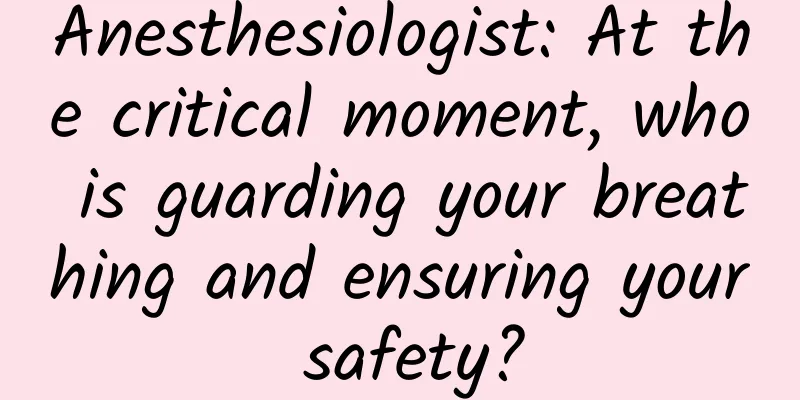Anesthesiologist: At the critical moment, who is guarding your breathing and ensuring your safety?

|
★Why do you need to fast and not drink for a specified period of time before elective surgery? ★Why patients with sleep apnea syndrome need to pay special attention when undergoing painless gastroenteroscopy ★Why do hospitals need anesthesiologists to urgently establish an artificial airway when rescuing patients? ★What other tricks do anesthesiologists have to ensure the patient’s respiratory safety? I believe many people have tried the breath-holding test. Many people have experienced breath-holding competitions in swimming when they were young. When holding your breath, you cannot breathe temporarily, and after a while you will feel very uncomfortable. If you hold your breath for too long, it will lead to hypoxia and even suffocation, threatening your life. It can be seen that normal breathing is the basic demand of human beings to maintain life and is also an instinct for survival. In addition, we can also find an interesting thing when watching TV dramas, that is, if someone faints accidentally, others will put their hands under his nose to see if he is still breathing, so as to determine whether he is dead or not. This shows the importance of respiratory function. Breathing is the source of life, and keeping the airway open is the prerequisite for completing breathing and oxygenation. The major cause of death of patients caused by many accidents or incidents is airway obstruction or airway obstruction, which in turn causes patients to suffer from hypoxia and suffocation, or even death. Anesthesiologists are airway management experts who ensure that the patient's airway is unobstructed. What are the situations in which the anesthesiologist controls the "airway"? It is said that "surgeons treat diseases, and anesthesiologists save lives." How do anesthesiologists save lives? During surgery, the job of anesthesiologists is to make the patient feel painless and safe. The first priority of safety is to ensure the stability of breathing and circulation. In layman's terms, it means ensuring that the patient breathes smoothly, has a normal heartbeat and blood pressure during various operations. Most anesthetic drugs have a certain degree of respiratory and circulatory inhibitory effects, so the role of anesthesiologists in the perioperative period is self-evident and vital. Airway management plays the most important role in the anesthesia management process. Like any other "pipeline", to keep the airway open, both ends must be open and the middle must be open. Generally, the anesthesiologist will require the patient to fast and abstain from water for a certain period of time before the operation to ensure that the stomach is empty during the operation and reduce the risk of aspiration lung injury caused by reflux of gastric contents during and after the operation (refluxed materials enter the lungs through the airway and cause aspiration lung injury). For patients who are overweight or have sleep apnea syndrome, they are prone to airway obstruction even under light anesthesia due to adenoid hypertrophy, tongue prolapse, and short neck, which threatens the safety of the patients. Therefore, when these patients make an appointment for painless gastroenteroscopy, the anesthesiologist will be very cautious and make a careful assessment. In special cases, emergency plans will be established to reduce the risk of suffocation. Friends who have had hospitalization experience probably know that when informing the patient of the condition before surgery, doctors often ask family members to sign a "notice of whether or not to accept invasive rescue in case of an accident", and "endotracheal intubation" is one of the invasive rescue measures, which can save lives at critical moments. At present, according to the medical practice in our country, the "endotracheal intubation" operation is usually performed by anesthesiologists and emergency doctors. This is mainly because the doctors in these two departments usually perform "endotracheal intubation" more frequently, are skilled in technology, and have a high success rate. At the beginning of the outbreak of the new crown epidemic, the isolation hospital that admitted new crown patients specially formed an "endotracheal intubation team". When necessary, they can quickly control the airway of critically ill patients, perform artificial ventilation, ensure the patient's oxygen supply, and save the patient's life at a critical moment. Of course, "endotracheal intubation" only establishes an airway access. The main purpose is to support the patient's respiratory function through airway management and ensure life safety. How do anesthesiologists control the "airway"? Depending on the size of the surgical trauma, the body position, and the length of the operation, the anesthesiologist will choose different tools to control and manage the airway, mainly including the following categories. The operating room of the Department of Anesthesiology at Dongzhimen Hospital of Beijing University of Chinese Medicine has introduced various advanced visual airway equipment to ensure the basic life safety of patients. For patients undergoing lung or large airway surgery, airway management will be difficult, and anesthesiologists need to use highly professional and difficult ventilation strategies such as single-lung ventilation and high-frequency ventilation to manage the patients. The medical team led by respiratory disease expert Director Wang Hongwu has carried out various types of emergency and critical airway intervention surgeries, including various airway and lung tumor resections, end-stage airway recanalization, large airway stenosis correction, tracheoesophageal fistula treatment, airway stent implantation, photodynamic therapy, argon plasma coagulation, laser resection, etc., providing life-saving treatment options for "desperate" airway disease patients across the country, giving them a chance to survive. Since patients with airway diseases already have airway obstruction and hypoxia before surgery, interventional airway surgery requires the insertion of a rigid bronchoscope, which causes significant stimulation and trauma and requires deeper anesthesia. Therefore, during anesthesia induction, severe hypoxia and further airway obstruction may occur, requiring the anesthesiologist to have more "advanced" emergency airway management capabilities. Of course, the work of anesthesiologists goes far beyond this. For example, before surgery, they need to fully understand the patient's condition and conduct a comprehensive assessment; during surgery, in addition to anesthesia, they also need to monitor the patient's vital signs in real time and handle emergencies in a timely manner; after surgery, they need to manage pain and prevent nausea and vomiting to improve the patient's postoperative outcome. Therefore, anesthesiologists play an important role in all aspects of perioperative management of patients. There are big and small surgeries, but anesthesia is no small matter! We are the guardians of life - anesthesiologists! |
<<: Young people, if you find that your blood pressure is high, you have to control yourself
>>: Such changes may indicate Parkinson's disease!
Recommend
Does having an abortion before affect pregnancy?
For women who have had abortions before, their en...
What to do if you have a cyst on your ovary
There are many symptoms of ovarian cysts, which g...
What is the reason why my period always comes early?
The period from the first day of menarche to the ...
What are the ingredients of mascara? What should I do if my mascara dries up?
Mascara is a must-have item for female friends to...
What are the precautions for forest fire prevention? How is the global forest area changing?
According to the central location of forest fires...
Why do lily buds turn yellow? How to remedy the yellowing of lily buds?
Lily is very common in life. It is loved by flowe...
What causes leukoplakia?
Many patients are reluctant to face the appearanc...
What causes cervical motion pain
Many people do not know much about cervical tende...
Dry and thick stools during breastfeeding
Constipation during breastfeeding is a common pro...
What is the normal progesterone level at 60 days of pregnancy?
We know that the progesterone level of women afte...
What causes ovarian cysts?
In today's life, the incidence of gynecologic...
Bleeding like menstruation in 3 months of pregnancy
The menstrual period will stop after pregnancy. I...
That night, they won two "battles to save their lives"!
"Thank you! Director Pu, you saved two lives...
Why does urination pain occur after childbirth?
Mothers who have just given birth have many thing...
What is the meaning and symbolism of yellow chrysanthemum? What are the effects of chrysanthemum?
There are many varieties of chrysanthemums. Accor...









